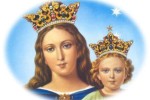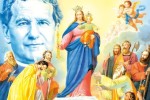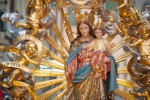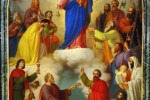MAMT||Museo Mediterraneo dell' Arte, della Musica e delle Tradizioni (EN)
24 May 2017
Iniziative (EN) -
MAMT – Mediterranean Museum of Art, Music and Traditions

"Auxilium Christianorum "," Help of Christians ", is the title that has been given to the Virgin Mary at all times and so it is also invoked in the Lauretan litanies of the Rosary. On virtues, life, predestination, motherhood, mediation, intercession, virginity, immaculate conception, pain suffered, Mary's assumption, thousands of volumes have been written, kept by various Councils, proclaimed dogmas of faith, to the point that an authentic theological science has arisen: Mariology. And the mediating and rescuing presence of Our Lady has always been reaffirmed for those who invoke her, we have been entrusted to her as children of Jesus on the Cross and to us humanity she has been indicated as mother, in the person of John the Apostle, also at the foot of the Cross.
The invocation Auxiluimchristianorum, now pro nobis, appears for the first time in the version of the Lithanias published in 1576 and approved by Pope Clement VIII in 1601; it was absent in the oldest version, dating back to 1524. According to tradition, this invocation was added by Pope Pius V after the victory given by the Holy League over the Ottomans in Lepanto (7 October 1576), but more probably represents a variant of the title Advocatachristianorum which is found in the 1524 edition. The title (together with those of Advocate, Soccorritress and Mediator) is also used in the Dogmatic Constitution on the Church Lumen Gentium of 1964. In any case, the official use of the title "Auxilium Christianorum" was made with the invocation of the great Marian and Dominican pope Saint Pius V (1566-1572), who entrusted her with the armies and destinies of the West and Christianity, threatened for centuries by the Turks who arrived to Vienna, and who in the great naval battle of Lepanto (1571) faced and conquered the Muslim fleet. The pope instituted for this glorious and definitive victory, the feast of the Holy Rosary, but the grateful invocation to the heavenly Protector as "Auxilium Christianorum", does not seem to have to be attributed directly to the pope, as was then said, but to the victorious veterans who, returning from the battle, passed by Loreto to thank Our Lady; instead, the banner of the fleet was sent to the church dedicated to Mary in Gaeta. The cry of joy of the Christian people perpetuated itself in this invocation; the Venetian Senate had written under the great commemorative painting of the Battle of Lepanto, in the Doge's Palace:"Neither power, nor weapons, nor leaders led us to victory, but Mary of the Rosary" and so alongside the ancient titles of Consolatrixafflictorum (Consolator of the afflicted) and Refugiumpeccatorum (Refuge of sinners), was added for the people and for the Church Auxilium Christianorum (Aid of Christians).
The feast of Mary, Help of Christians, was instituted by Pope Pius VII on 15 September 1815 and fixed at 24 May in memory of his triumphant return to Rome (24 May 1814) after his imprisonment under Napoleon in Fontainebleau. Originally the feast was limited to the Church of Rome, but it was soon adopted by the Tuscan dioceses (1816) and then extended to the universal Church.
The cult, even though it continued in the following centuries, had ups and downs, until in the nineteenth century two great figures of Catholic holiness, on different streets, revived the devotion for the Madonna del Rosario with Blessed Bartolo Longo in Pompeii and for Our Lady Help of Christians with St. John Bosco in Turin. The great educator and innovator from Turin, put his work as a priest and founder from the beginning, under the protection and help of Mary Help of Christians, to whom he addressed himself for all necessities, especially when things went long and tangled up; he said to her:"And then do we begin to do something? St. John Bosco, born on 16 August 1815 at Castelnuovo d' Asti and ordained priest in 1841, was the greatest devotee and propagator of worship to Mary Help of Christians, whose feast was instituted under this title and placed on 24 May, a few decades earlier, by Pope Pius VII on 24 May 1815, in thanksgiving to Mary for her liberation from the now five-year Napoleonic imprisonment.
The great priest, apostle of youth, had the basilica of Maria Ausiliatrice erected in only three years in 1868 in the Salesian citadel of Valdocco - Turin; under his maternal protection he placed the religious Institutes he founded and now scattered all over the world: the Congregation of St. Francis of Sales, priests normally called Salesians of Don Bosco; the Daughters of Maria Ausiliatrice founded with the collaboration of St. Maria Domenica Mazzarello and lastly the Salesian Cooperators for lay people and priests who intend to live the spirit of "Don Bosco", as it is generally called.
The Congregations are so numerous, that we can see with gratitude the benevolent protection of Maria Ausiliatrice in the diffusion of many charitable works and in favor of youth. By now, Our Madonna Ausiliatrice has become the' Madonna of Don Bosco', it is inseparable from the great Salesian Family, which has given the Church a host of saints, blessed, venerable and servants of God; all children who have entrusted themselves to the help of the sweetest and most powerful mothers.
Whole continents and nations have Maria Ausiliatrice as their Patroness: Catholic Australia since 1844, China since 1924, Argentina since 1949, Poland since the first decades of 1800, widespread and ancient devotion in Eastern European countries. In the beautiful basilica of Turin dedicated to her, where her devout son John Bosco and other saintly Salesian figures are buried, there is the beautiful and majestic painting, executed by the same founder, who represents Our Lady Help of Christians who with the scepter of command and with the Child in her arms, is surrounded by the Apostles and Evangelists and is suspended on a cloud, in the background on the ground, the Shrine and the Shrine. The meaning of the whole picture is very clear; just as Mary was present together with the apostles in Jerusalem during Pentecost, therefore at the beginning of the Church's activity, so she still stands to protect and guide the Church over the centuries, the apostles represent the pope and bishops.
Great feast at the Peace Museum with connections to the Basilica of Valdocco.









